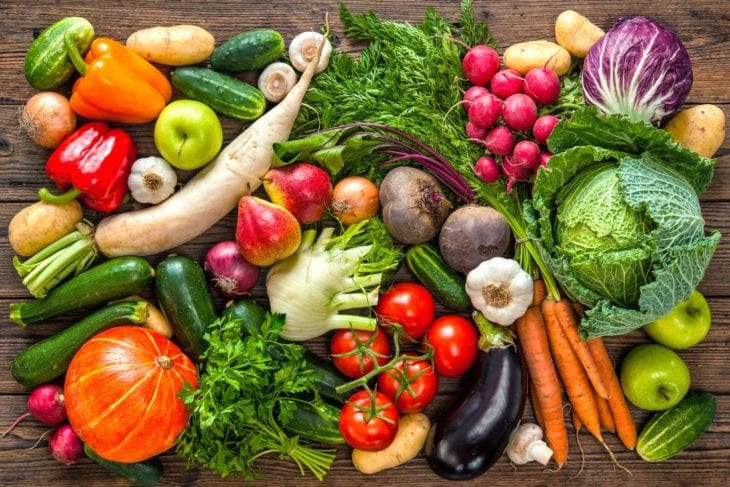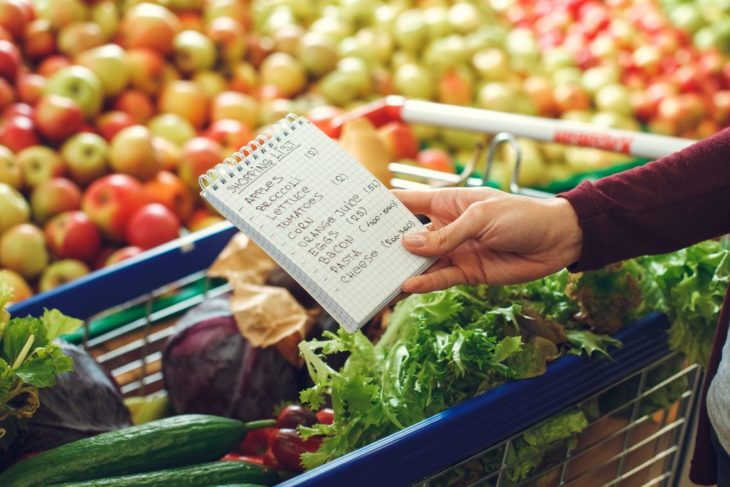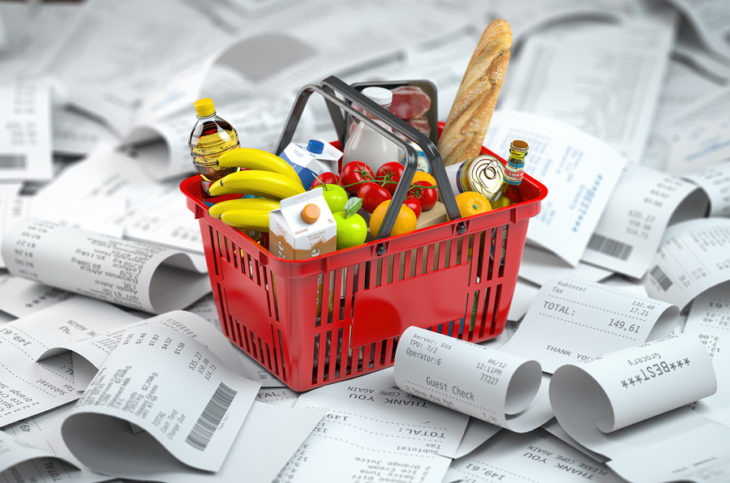When you’re looking to trim your budget, it can be easy to cut down on what you spend on food. You can stop getting that latte every morning on your way to work and eat like you’re still in college. (Ramen, anyone?) But what if eating well is a priority, too? Elizabeth Somer, registered dietitian and author of Eat Your Way to Happiness, offered these tips for keeping both your diet and your checkbook balanced.
Contents
1. Focus on fresh fruits and veggies

Source: Medical News Today
Somer says that as Americans, we average three to four vegetables a day instead of the recommended nine. Our top choices? The potato and iceberg lettuce, nutritious lightweights in the world of vegetables. And if they already didn’t fall short enough on the nutrition scale, we make them worse by frying the potato or drowning the lettuce in creamy dressings. Remove these vegetable slackers from the equation, and many Americans are lucky to be getting one serving a day. By filling your cart with plenty of produce and less of the processed foods found in the center of the store’s floor plan, you’re going to be eating better and paying less.
Somer isn’t suggesting that you become a vegetarian, though. Follow the food pyramid, yes – but chances are, you’re already getting more than enough protein. Just reduce the number of calories you’re getting from meat and amp up how many fruits and vegetables you’re eating, and not only will your grocery bill plummet, but so will your risk for all kinds of diseases.
2. Accept that organic doesn’t mean healthy
“It’s way more important to include foods like broccoli and grapes in your diet than it is to break the bank buying organic,” Somer advises. “Don’t fool yourself into thinking an organic cookie is better for you than a regular cookie.”
“Organic isn’t worth it if you’re looking to improve nutritional quality of meals,” Somer explains. “It is, however, worth it if you’re looking to save the environment. If you can afford to splurge on an all-organic diet, it’s much better to spend your money on organic produce than another pair of shoes. But anyone on a tight budget will realize more benefits from including more colorful fruits and veggies than focusing on organic alone. The fact is that nine servings of colorful fruits or vegetables have all the nutrients you need to be healthy – without having to buy organic.”
If avoiding anything with pesticides is a priority and you can afford the higher price tag that comes with organic, that’s great. Somer just warns you not to let that organic label give you a false sense that you’re eating something healthy. “If something is labeled organic, it doesn’t mean it’s lower in fat, calories, salt, or cholesterol.” Don’t sacrifice buying food like fruits and vegetables because you’re reaching for the organic junk food. “If you’re following an all organic diet, you don’t want it to cost you nutrients from other foods,” Somer says. “It’s hard to find organic salmon, for example, but you need omega 3s that foods like salmon provides. It’s much healthier for you to eat eggs fortified with omega 3s and DHAs instead of searching for the non-fortified but organic options.”
Bottom line? Organic food is great for the environment, tough on your pocketbook, and tough to justify nutritionally, so pick your foods carefully.
3. Cook at home

Source: Playbuzz
Somer says that sugar is added to almost all processed foods nowadays, and she isn’t kidding. From 100-percent fruit juices (yep!) to yogurt and bread, added sugar is a lurker in ingredient lists that can sabotage the best-intentioned shopper. Even the frozen food aisle, friend of working women everywhere, can hide all kinds of nastiness you and your family don’t need. Those frozen entrees that don’t taste even remotely sweet? Somer says they can contain up to seven to nine teaspoons of sugar. (Tip: Look for anything ending in –ose or syrup in the ingredient list. These are all types of sugars, and many processed foods contain more than one kind.) So walk right past that frozen dinner aisle and grab the fresh stuff to make at home.
You can pull this off even if you’re crunched for time. A Google search will provide you more easy meals than you can make in a week, and working ladies can cook in bulk on the weekends and eat their own frozen meals throughout the week. With a little planning, you can find a way to cook meals at home, all of which can be assembled with fresh, healthy (cheap!) ingredients.
4. Find a local vendor
Now that you know to shop heavily for fruits and veggies, find a local vendor to buy them from. This can take a little more time than just running to the local supermarket, but it’s worth it. Somer says that buying from a local farmer can be a great way to save money while getting healthier produce fresher from the field. “If you know the vendor’s hours and come in at the last minute, you can get a great deal—a local farmer won’t want to pack up their produce and take it home and may give it to you at a discount. Additionally, if you purchase from the same farmer every week, you may find that they start setting aside choice produce for you or start offering you better deals than customers they don’t know.” An added bonus with buying locally grown produce is that it hasn’t had to travel far to get to your plate, which helps reduce your carbon footprint even if it isn’t certified organic.
5. Buy in season

Source: AdobeStock
We’re spoiled by the availability of produce. If I want to make strawberry shortcake, I know that I can run to my local grocery store any month of the year and find the ingredients. But Somer says that breaking this mindset can be a great way to increase the nutritional value of your food while on a budget. “You can save a ton of money a year if you just pay attention to buying in season,” she says. But sometimes a girl just has to have her berries. Somer says a little bit of planning can get you the best of both worlds. “For example, when blueberries are in season, I buy them in bulk and freeze them,” she says.
6. Shop frequently
The key to getting the most nutritious produce is to buy and eat it as fresh as possible. Your best bet is to shop locally or learn what days your supermarket gets deliveries and shop that day. If you buy less produce but shop every few days, you’ll find yourself throwing away less food, which is a no-brainer way to make the most out of your grocery dollar. (Plus, the longer food sits on the shelf or in your fridge, the more nutrients it loses.) Somer says that bulk supercenters like Sam’s or Costco can be a great way to shop on a budget for foods like produce and grains. And don’t ignore the supercenters if you’re single or cooking for just you and your man. Sure, you may not eat 12 mangoes in the next few days, but if you shop with friends and divide the produce you can be sure you’re getting great food at a great price.
7. Ignore the front of food labels

Source: bigstock
When you’re shopping, Somer tells you to ignore the front of the food package. “Don’t believe anything you read on a label!” she warns. “The entire front of the label is marketing and tries to appeal to your intellect and emotions.” Instead of falling for the label calling your name with colorful promises of organic, all natural, or whole grain, Somer tells you to look straight to the ingredient list. “Always go to the back of the package. Go to ingredients and nutritional panel. Even all-natural and organic products can be drenched in saturated fat and loaded with refined sugar and be nothing more than well-marketed junk food.” These labels on processed foods can lull you into a false sense of security about the health of your diet. “Most of us think we eat okay, but we don’t,” says Somer.
8. Buy the real deal
There’s a limit to what you’re going to be able to buy in its natural state. You probably don’t want to make your own bread, for example, so sometimes you just have to buy processed foods. But whenever possible, buy the real food – not a processed version that’s far from its natural form. “Eat old-fashioned oatmeal and not a granola bar, have the potato and not the fry. If you just eat foods as untouched as possible, you will eat a healthy diet,” says Somer. And yes, this will benefit your bank account, too. “A raw potato’s always cheaper than a bag of potato chips,” Somer says. “Buy the real produce and you will save a ton of money a year.” Stick with whole grains (not 12-grains or other misleading labels that sound healthier than they are), low sugar, high protein, and tons of produce, and you’ll be on your way to a healthier diet. And making such informed choices will reduce your grocery bill – organically.
Got any other tips for eating healthy without blowing the bank? Share them in the comments!
Original by Colleen Meeks
